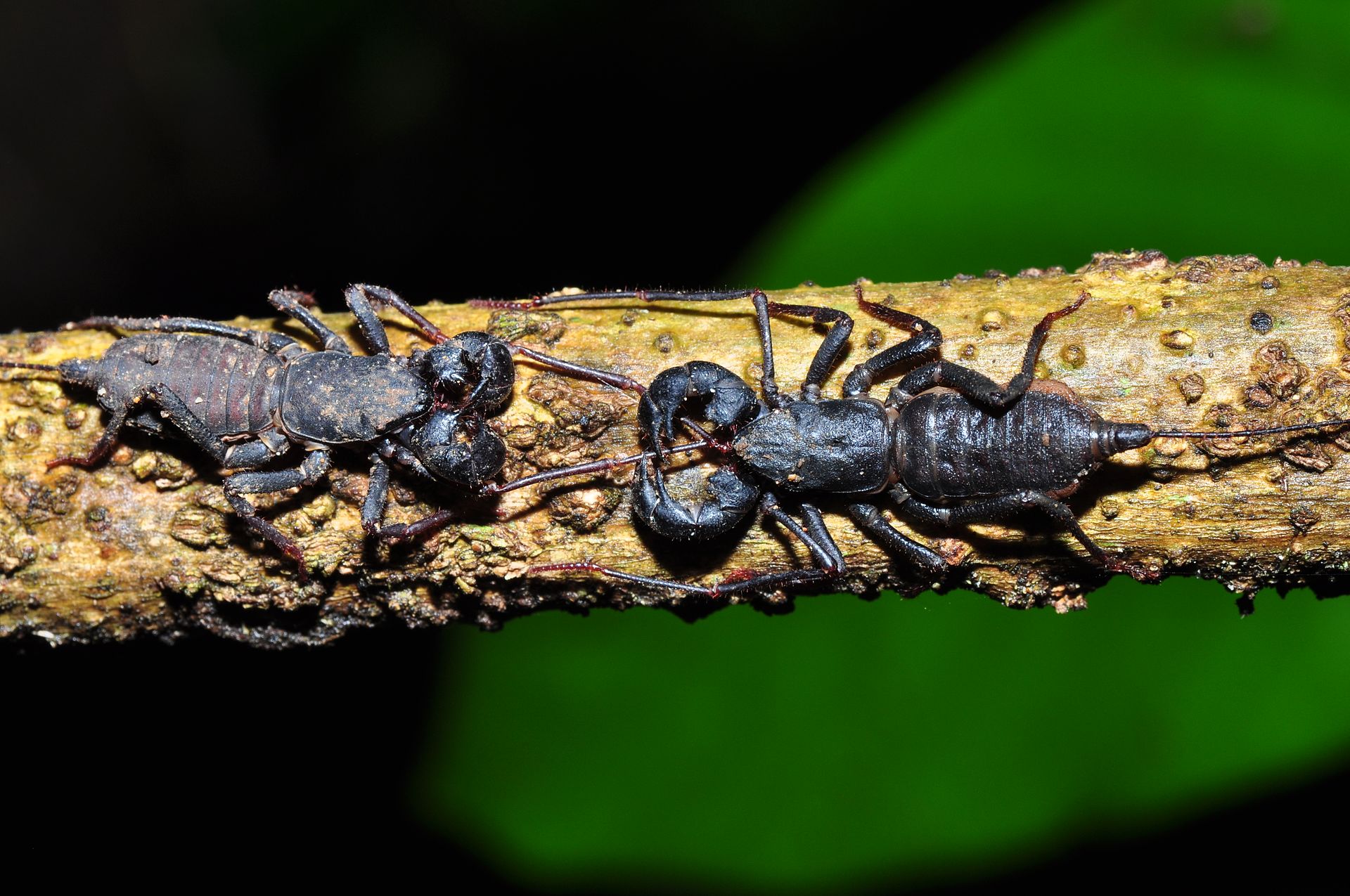
What is a Vinegaroon?
A vinegaroon is often referred to as a “whip scorpion,” although it is really not a scorpion at all. Like the scorpion, the vinegaroon is an arachnid, but it is actually more closely related to a spider than a scorpion. Contrary to the spider and scorpion, however, the vinegaroon lacks a venomous defense such as a sting or bite. The vinegaroon’s main defense is its ability to spray concentrated acetic acid from its whip-like tail. Being that acetic acid is the main ingredient in vinegar, the vinegaroon’s spray smells just like the common household solution, giving the arachnid its namesake. The big difference, however, is that household vinegar is only made up of only 5% acetic acid whereas the vinegeroon’s spray is made up of 85% acetic acid!

What Do Vinegaroons Eat?
Similar to spiders, vinegaroons are nature’s pest control. They are carnivores; in the wild, their diet consists of slugs, worms, and insects such as crickets, termites, and cockroaches. Spiders and vinegaroons are essential to keeping these pest populations under control so that they do not overwhelm their ecosystems. At WonderLab, the vinegaroons’ diet is alternated between crickets and cockroaches. Giving the vinegaroons varying live prey to hunt in a secure area keeps them mentally stimulated.
Where Do Vinegaroons Live?
Vinegaroons can be found in the southwestern United States including New Mexico, Texas, and Arizona. Their range extends south through much of Mexico and they have even been found in Florida. Vinegaroons live in arid, desert habitats in the southwest and the scrub forests and grasslands in Florida.
WonderLab’s animal care team ensures the enrichment of these animals by rearranging the rocks and branches in the enclosure, switching up the substrate, and misting to simulate rain. When the vinegaroon’s environment is changed, it encourages them to move around and explore, dig new tunnels, and rediscover old things in new ways. The changing of the surroundings simulates an ever-changing natural environment.
Mating and Motherhood
Vinegaroons have a very complicated, multi-step, 12-13 hours long mating process that happens during the night in the fall season. The first step of the process can often be the last step as well, as many times the female does not want to accept the male’s advances, which leads to fighting. If the female accepts the male, then she will approach the male head first. The male will grasp the female’s front legs and pull her forward towards him. The female will then back up, and the process will repeat. This back-and-forth courtship lasts several hours. After a while, they will both turn the same direction and the male will release a spermatophore onto the ground, which holds the sperm, and the female will stand over it and pick it up to fertilize her eggs.

Photo by Pavel Kirillov
Female vinegaroons will carry fertilized eggs for a few months before they eventually lay a sac that is filled with 30-40 eggs. She will then carry the sac underneath her abdomen for months, hiding in a burrow motionless thereby allowing the eggs to grow safely. The eggs will hatch and climb aboard mom’s back for about a month until after their first molt, after which she will die of exhaustion.
Sources
Animal Diversity Web. Mastigoproctus giganteus. Retrieved March 11, 2022 from https://animaldiversity.org/accounts/Mastigoproctus_giganteus/
BioKids’ Inquiry of Diverse Species. Mastigoproctus giganteus. Retrieved March 11, 2022 from http://www.biokids.umich.edu/critters/Mastigoproctus_giganteus/
Conservation Society of California, Oakland Zoo. Giant Vinegaroon. Retrieved March 11, 2022 from https://www.oaklandzoo.org/animals/giant-vinegaroon
Field Guide to Common Texas Insects. Vinegaroon. Retrieved March 11, 2022 from https://texasinsects.tamu.edu/vinegaroon/
Toronto Zoo, Arachnid. Vinegaroon. Retrieved March 11, 2022 from
https://www.torontozoo.com/animals/Vinegaroon?__cf_chl_jschl_tk__=jKKWtC2PJs9XIfZ8zx8LkOfN5CS.SsHGsGIURUqSt.E-1637871204-0-gaNycGzNCL0
 About the Author: Bridget Huck is a Development Intern at WonderLab. She grew up as the girl who was always outside catching bugs, garden snakes, frogs, and minnows (then releasing them later, of course.) She loves learning about how all the animals in an ecosystem are essential to its success, whether they be big, small, creepy, and/or crawly.
About the Author: Bridget Huck is a Development Intern at WonderLab. She grew up as the girl who was always outside catching bugs, garden snakes, frogs, and minnows (then releasing them later, of course.) She loves learning about how all the animals in an ecosystem are essential to its success, whether they be big, small, creepy, and/or crawly.

Leave A Comment